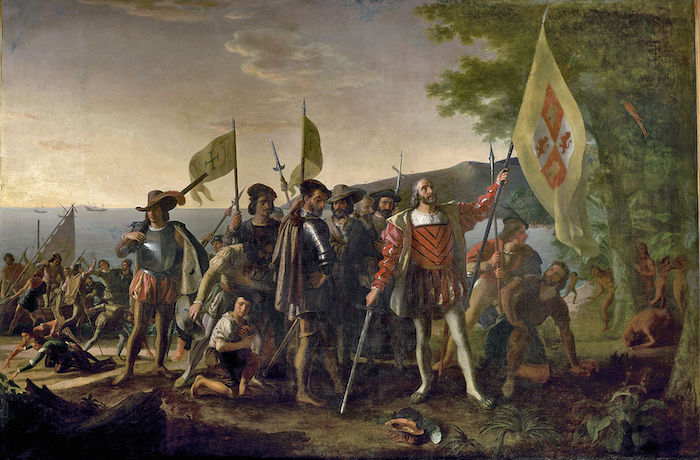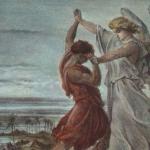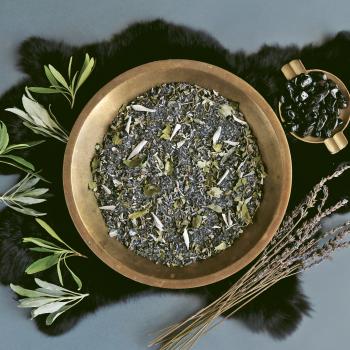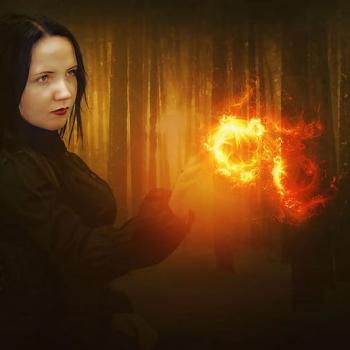In this culture, we are cued to respect people who Have. American culture teaches that motivation, hard work, and dedication are keys to success, and those who have achieved this station in life are worthy of honor. This is a free country, so they say, and we – in the Western world – supposedly have the power to shape our own destinies. Therefore, we may regard success as a reward for diligence. This notion is rooted in European feudalism, wherein the lord of a manor had power and respect, though peasant serfs led lives of toil and lacked free will and voices. These ideas were brought to the new world by colonists, who valued conquest as a sign of strength and power, land ownership as a status symbol. To control the land, to define boundaries between places and people, was not seen as tyrannical but respectable – the mark of a powerful lord.
The most important of all American ideals is said to be freedom, yet Columbus Day is testament to the fact that our culture values power and conquest over equality and respect for human life. Why was Columbus made a hero, despite his heinous and obvious misdeeds, while early Americans who were merely accused of supernatural evil were tortured and killed in the name of witchcraft? These ironies of American history are at the root of current dysfunctional cultural norms. White dominance has been the way of the world historically, and conquest has long been praised as heroic. As the old saying goes, “History was written by the winners.” The powerful lord, the one enjoying the position of advantage, is the one who can literally get away with murder, even while accusing others.

But these days, many of us are rethinking these values shaped by European colonists. The general public is at least discussing the concept of white privilege, as compared with the relatively higher level of adversity faced by non-white demographic groups throughout American history. Many American parents are now questioning the tradition of teaching children to honor a historical figure who was responsible for the enslavement and genocide of human beings. Should we be teaching American children to respect someone who valued gold over human life? Certainly not while we are discussing the wrongness of bullying. After all, it is more accurate to call the Europeans immigrants; this re-frames their conquest as an act of bullying rather than a mark of human progress that advanced civilization. It is a more honest discussion of history, one that can help our nation step away from institutional racism.
Why is this subject an important one for Neo-Pagans? Because tribal culture has been an important influence on modern Pagan subcultures. This brings to mind a conversation I had with my old priestess, who noted that most of the people she saw at Pagan festivals were “white and middle class.” At the time, I was one of those people who thought it unnecessary and sort of rude to call attention to such things, but since taking a master’s degree deeply steeped in sociological topics, I now can appreciate where she was coming from. And, yes – she was white and middle class, herself. She was making a demographic observation regarding who had the means and interest in attending such events. While we Neo-Pagans were “turning on, tuning in, and dropping out” (a phrase coined by notorious acid guru, Timothy Leary), – at least for one week out of the year at the Starwood Festival – part of what we were trying to accomplish in the course of our spiritual growth was to transcend layers of indoctrination and conformity that had been drilled into us since birth, and experience a state of openness and innocence in our ability to connect with one another in a circle of “perfect love and trust” or at least mutual respect – a concept that, like the rhythms of the drums played at Pagan gatherings, has more in common with tribalism than linear, hegemonic, corporate America.
How ironic that white Europeans “conquered” and enslaved indigenous people all over the world, defining the ways of those people exotic at best, ignorant at worst, and now their descendants turn to those ways to unravel inner truths , to become more “spiritual,” or perhaps more human, more real, more connected with nature. And the white demographic is the statistical majority, partly as a result of historical genocide. Are we appropriating? When sociologists examine such scenarios, they inquire: How do the people who inspired these white-dominated subcultures fare? If the answer is, “Not well,” it is seen as a sign of appropriation rather than cultural diffusion. Not that I am pointing fingers. I am white, middle class, Pagan, and have been judged too pale to have played a gypsy at a Renaissance Fair. I didn’t mean any disrespect. I felt a sincere identification with people deemed outsiders. But I can understand why people might be offended by that. Also, I study belly dance, which draws heavily from Middle-Eastern culture. While my passion for belly dance is sincere, and I would also say that for the three European-American women whose belly dance classes I attended, I have thought about how social advantage and Western values of competition and conquest affect our approach to subcultures such as Paganism and belly dance that may be attractive to us partly because they seem ‘exotic,’ ‘other,’ or less vanilla than the humdrum comfort and security of the suburbs. Those things, in turn, can make *us* seem more colorful or interesting.
The occult movement in the Western world was influenced by figures who enjoyed white privilege, such as Aleister Crowley, Gerald Gardner, Carl Jung, and Madame Blavatsky. These are individuals who traveled, and studied indigenous cultures; they wrote with authoritative voices regarding cultures which they observed from the outside, looking in. Perhaps we continue to be influenced by their example, as we have a habit of projecting our own conceptions onto ideas and traditions that are foreign or “exotic” to us, speaking authoritatively as we compete for respect in hierarchical communities, sometimes consciously or unconscioulsy bullying other voices – especially voices with lower social status – out of the conversation. If we view this as the complex cultural phenomenon that it is, rather than approaching it as a matter of virtue versus immorality, we might stand a chance of breaking the cycle of dysfunction – but would that threaten the social order? Perhaps this is why tribalism has been described as “counter-culture.” Tribal ways are beyond those of the status quo as we know it in Western society, because in a circle we stand as equals.
If you are a lucky Pagan, as I am, you may have experienced a feeling of “perfect love and trust” while standing in a circle, holding hands with other Pagans. But, at times, I have pondered: You can take the white middle-classer out of corporate America, but can you take corporate America out of the white middle-classer? While we are cockfighting with other whites over who is the brightest star among the belly dance divas, or who knows more about the Pagan (and perhaps tribally influenced) tradition of our affiliation, are we aware of how advantaged we are in comparison to actual tribal, foreign, or otherwise vulnerable populations whose ways inspire us – even in our ability to express our passion for these cultures? Still, in present times, indigenous peoples struggle to defend their basic human rights, and missionaries continue to try to convert them, as though there is only one true religion. The fact that we are in the habit of constantly trying to outdo one another is evidence of the fact that we get to have our cake and eat it too: We can turn to vulnerable populations for inspiration and ideas while also competing in arenas reserved for the privileged.
Many years ago, as a young witch I conducted a solitary ritual at a local landmark, a Revolutionary War era battlefield. It was a gorgeous autumn day, the sun glinting on the leaves as they trembled in the breeze. The site was open, but I was alone there, as I somehow knew I would be. I remembered visiting there as a child; my father thought it important to educate me about history. There is a stillness to the place, except for the occasional unexplained noise in the distance which does not strike you as unusual until you leave, and reflect back on it. There are picnic tables not far from the giant monument, but I have never seen anyone eat there. There is a sad loneliness, even though a strong effort was made long ago to welcome visitors.
I parked the car and walked across the battlefield that seems to go on forever. One of the bloodiest battles of the American Revolution was fought there, and it’s hard not to think about that as you cross the grass, once covered by so many dead bodies that they could not all be identified and buried. This battle involved Native Americans, American Revolutionary Patriots, and Tories. I felt sorry for all ensnared in the ruthless politics of war. But most of my empathy lay with Native Americans, who tried to adjust to the changing world and fought so hard, only to be cheated out of their voice, and their land. This particular battle divided families and friends on all sides, including a five-hundred year alliance between five Native American tribes of the Iroquois Confederacy.
I felt sorry for the blood-soaked land that seemed unhealed. I wanted to send a message to the spirits there. I wanted to offer healing to the land. I had brought an offering of cream with me, and planned to share it in the creek notorious for having run red after the battle. The path leading to the creek was barely visible in the thick autumn grass, some of which stood taller than I. As I followed the sound of the water down the hill, I felt a change in the energy around me, as though I had crossed a threshold. The experience was going exactly as I had envisioned it would, except for the feeling. What I had not anticipated was the feeling I would have as I stood there looking above me at the trees and sky, speaking to the spirits, looking down at the earth and water, speaking to the land.
Small. I felt small standing there. I spoke respectful words, acknowledging the ugliness of war and oppression. My words intended to “heal.” But as I stood in the midst of the tall brush I did not feel the peace that I normally felt while standing in nature, communing with spirits. I did not feel welcome. But I went through with my “spell,” my message.
I made the offering. The stream did not carry the cream in a natural way. It seemed to sink to the ground the way bad news hits the stomach, striking the sediment beneath the water before coming back up, like vomit mixed with dirt, in the shape of a mushroom cloud. I watched in disbelief as this body of water defied anything I had ever seen. It wouldn’t run clean. There was a churning flotsam circling around in the water as though something had been disturbed there. No flushing, no cleansing, no resolve. I did not feel a sense of grace, but the unrest of something more enormous than I could have imagined at that time in my life. I felt the reality of those people, in that place and time, reverberate through me. And I understood through gnosis that what I was trying to heal was beyond my comprehension. I hated to admit to myself how afraid I felt… so out of control, not like a witch at all. I stood in the silence as faces in the shadows of leaves, bark, and rock told me I was a fool.
It was a long walk back to the car. As I watched the sun go down beyond the forest in the distance, I internally thanked the spirits and the land for refusing to indulge my ego, for teaching me respect. They did not allow me to have the satisfaction of feeling like I could walk into their world from the outside with just the thing they needed. They did not allow me any easy answers. Consequently I left the battlefield a different person, truly a witch.
Carri Anne Yager-Parker is a solitary witch, with a background in the fields of Education and Social Work, and a lifelong student of the occult.













